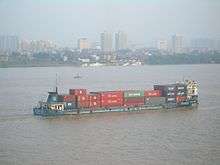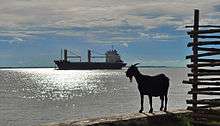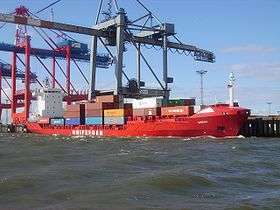Feeder ship
Feeder vessels or feeder ships are medium-size freight ships. In general, a feeder designates a seagoing vessel with an average capacity of carrying 300 twenty-foot equivalent units (TEU) to 1000 TEU. Feeders collect shipping containers from different ports and transport them to central container terminals where they are loaded to bigger vessels or for further transport by truck or rail into the hub port's hinterland. In that way the smaller vessels feed the big liners, which carry thousands of containers. Over the years, feeder lines have been established by organizations transporting containers over a predefined route on a regular basis. Feeder ships are often run by companies that also specialize in short sea shipping. These companies not only ship freight to and from ports like Rotterdam for further longhaul shipment, but also carry containers between smaller ports, for example, between terminals located on the north-west European seaboard and ports situated on the Baltic Sea coastline.



Feeder Class
Container ships are distinguished into 7 major size categories: small feeder, feeder, feedermax, panamax, post-panamax, new panamax and ultra-large.[1] Container ships under 3,000 TEU are generally called feeders, and operate as above.